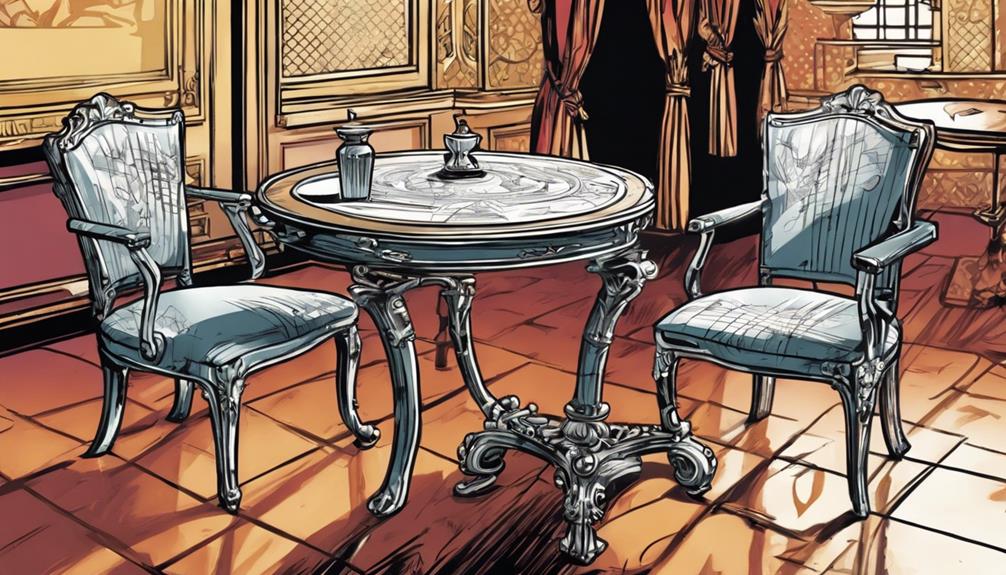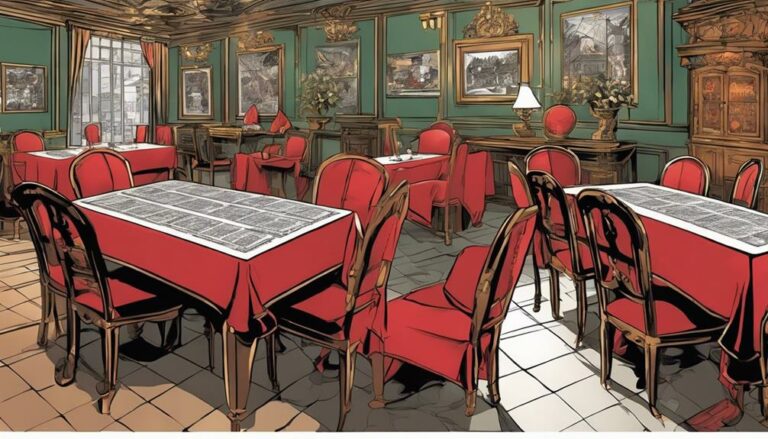In the domain of high-stakes card games, the distinctions between Chemin de Fer and Baccarat are not merely superficial. While both games share a common objective, the subtle intricacies of gameplay mechanics and strategic nuances set them worlds apart.
Understanding the strategic implications of choosing between these two variants is essential for any discerning player looking to elevate their gameplay. As we explore further into the complexities that define these games, a clearer picture emerges, shedding light on the considerations that can ultimately influence one’s choice between the two.
Unraveling the Origins and Evolution

The points of discussion center around the birth of Baccarat in Italy during the Middle Ages, its subsequent transformation into the French variation known as Chemin de Fer, and the global spread of both games with their unique variations.
Exploring these card games’ historical context and evolution sheds light on how they have adapted and diversified over time, appealing to different preferences and gaming styles worldwide.
The Birth of Baccarat
Originating in Italy during the Middle Ages, บาคาร่า has undergone significant evolution, leading to the development of Baccarat Banque and Chemin de Fer in France.
The game’s roots trace back to Italy, where it first emerged before making its way to France, where distinct variations like Baccarat Banque and Chemin de Fer were created.
Baccarat Banque introduced a fixed banker system, played with three decks, while Chemin de Fer innovated with a rotating banker and six decks, allowing for player negotiations during gameplay.
These developments in France marked a significant shift in the game, paving the way for different strategies and player interactions compared to the original Baccarat game played in Italy.
Transition into Chemin de Fer
Shifting from its roots in Baccarat, Chemin de Fer emerged in France in the 19th century as a sophisticated variation of the traditional card game, introducing innovative gameplay dynamics that set it apart from its predecessor.
In Chemin de Fer, players take turns acting as the banker, fostering a dynamic gameplay experience. The game’s utilization of six decks of cards adds complexity and depth to strategic decision-making, requiring players to adapt their tactics accordingly.
Moreover, introducing a negotiation phase in Chemin de Fer allows for strategic interactions among players during the betting process, enhancing the social and interactive aspects of the game.
This evolution from Baccarat to Chemin de Fer showcases a progression towards a more engaging and strategic gameplay experience for participants.
Global Spread and Variations
The global spread and variations of Baccarat and Chemin de Fer shed light on these card games’ diverse origins and evolution.
Understanding the emergence of Punto Banco, the uniqueness of Baccarat Banque, and the intricate gameplay nuances can provide insight into the cultural influences and historical developments that shaped these games.
Exploring how these variations gained popularity in different regions offers a glimpse into the rich tapestry of card gaming traditions worldwide.
Punto Banco Emergence
Emerging in Havana during the 1940s, Punto Banco marked a pivotal advancement in modern history and the global spread of baccarat variations.
- Simplified version of baccarat
- Originated in the 1940s in Havana
- Always played with the casino as the banker
- Widely popular due to its straightforward rules
Baccarat Banque and Its Uniqueness
Originating in France, Baccarat Banque distinguishes itself among baccarat variations by featuring a single player acting as the banker for an extended duration with a designated starting stake. The game utilizes three decks, establishing clear rules for drawing a third card. The banker’s advantage is predetermined, contributing to its popularity in Europe due to its historical significance and aristocratic appeal.
| Baccarat Banque | Details |
|---|---|
| Decks | Three |
| Third Card Rule | Structured |
| Banker’s Advantage | Predetermined |
| Popularity | Europe |
Understanding the Core Differences

When comparing Chemin de Fer and traditional Baccarat, key differences emerge in the roles of the banker, the unique gameplay rules, and the methods of scoring and winning.
Understanding the distinct roles each game assigns to the banker, the specific gameplay mechanics and rules that set them apart, and the scoring systems that determine the victor is essential for players looking to grasp the core disparities between these two variants.
The Role of the Banker in Each Variant
In Chemin de Fer, the banker role rotates among players, offering a dynamic gameplay experience, while traditional Baccarat maintains a fixed banker position.
This distinction impacts the strategic decisions and player interactions in each game variant. Understanding the contrasting banker roles is essential in grasping the core differences between Chemin de Fer and Baccarat.
Chemin de Fer’s Flexible Banker Role
One key feature that sets Chemin de Fer apart from traditional Baccarat is the dynamic and interactive nature of the banker role, which rotates among players during the game.
Players in Chemin de Fer can act as the banker.
Influence on game outcome and strategy.
Enhances player engagement.
Adds strategic depth to the gameplay.
Baccarat’s Fixed Bank Position
Chemin de Fer’s emphasis on player-driven banker rotations contrasts sharply with Baccarat’s static bank position, highlighting a fundamental distinction in the core gameplay mechanics between these two variants of the popular card game.
Baccarat’s fixed bank position guarantees structured gameplay, offering a standardized approach and a predictable gaming environment. This setup provides players with a consistent gaming experience where the house always serves as the banker, eliminating the need for negotiations or player involvement.
Gameplay and Rules Distinction
When examining the gameplay and rules of Chemin de Fer and Baccarat, a fundamental distinction emerges in the decision-making process. In Chemin de Fer, players have the autonomy to make strategic choices based on their hands and potential outcomes, fostering a more interactive gameplay experience.
Conversely, traditional Baccarat operates under predetermined rules, where players have limited influence over the game flow, emphasizing a more structured approach to gameplay.
Decision-Making Liberty in Chemin de Fer
In the game of Chemin de Fer, players enjoy a unique level of decision-making liberty that greatly influences gameplay dynamics and strategic outcomes.
- Players can choose to draw a third card based on their hand total and strategy.
- This freedom adds a strategic element not present in traditional Baccarat.
- Player choices can influence the game’s outcome, enhancing interactive gaming.
- Unlike Baccarat, Chemin de Fer allows active player participation in shaping the game.
Predetermined Rules in Baccarat
Amidst the kingdom of Baccarat, adherence to predetermined rules profoundly shapes the gameplay experience, distinguishing it from its counterpart, Chemin de Fer. In Baccarat, players have no say in drawing a third card, following strict guidelines. Below is a comparison table showcasing the key differences in predetermined rules between Baccarat and Chemin de Fer:
| Rules | Baccarat | Chemin de Fer |
|---|---|---|
| Player Hand | No decision-making power on the third card | Players can decide on drawing a third card |
| Banker Hand | Fixed rules dictate banker’s actions | Rotating banker’s decisions are player-negotiated |
| Third Card | Drawn automatically based on set rules | Players can choose to draw or stand |
Scoring and Winning
When comparing the scoring systems of Chemin de Fer and Baccarat, understanding the valuation of hands across variants is essential.
Additionally, the impact of third-card rules on odds plays a significant role in determining the winning hand.
Valuation of Hands Across Variants
The evaluation of hands in Chemin de Fer and Baccarat involves distinct scoring systems and strategic approaches to achieve winning outcomes.
- Face cards and 10s are valued as zero in Baccarat
- Aces are valued as one in Baccarat
- Winning in Chemin de Fer is based on a hand total closest to 9
- Drawing rules in Baccarat determines achieving a hand total beating the banker.
The Impact of Third Card Rules on Odds
Players’ strategic decisions on drawing a third card in Chemin de Fer and Baccarat Banque greatly impact the game’s odds and potential outcomes. In Chemin de Fer, decision-making flexibility regarding third-card draws adds a strategic element to the gameplay, influencing winning odds.
Conversely, Baccarat Banque follows fixed rules for the third card draws, affecting odds differently. Understanding these distinct third-card rules is important for players managing gameplay and maximizing their winning potential.
Strategic Insights and Winning Odds

Understanding the strategic insights and winning odds in Chemin de Fer and Baccarat requires grasping key gameplay elements.
Chemin de Fer offers players the opportunity to employ specific strategies for success, while Baccarat necessitates a focus on best betting practices.
Chemin de Fer Strategies for Success
Strategies for success in Chemin de Fer encompass tactical decisions regarding accepting or refusing a third card based on hand value, observing opponents’ actions and betting patterns, and maneuvering negotiations with the banker to assess odds and risks effectively.
- Accepting or Refusing a Third Card: Knowing when to take an additional card is pivotal for optimizing hand value.
- Observing Opponents’ Actions: Analyzing how opponents play their hands can provide valuable insights for making strategic decisions.
- Betting Patterns: Recognizing patterns in how players bet can help anticipate their moves and adjust strategies accordingly.
- Negotiating Betting Amounts: Skillful negotiation with the banker on bet sizes can impact potential winnings and losses to a great extent.
Baccarat’s Best Betting Practices
When it comes to maximizing your chances of winning in Baccarat, understanding the importance of managing your bankroll and determining the best bet sizes is key.
Additionally, familiarizing yourself with the tableau of drawing rules can provide valuable insights into making strategic decisions during gameplay.
These points serve as foundational elements for developing a successful betting strategy in Baccarat.
Managing Bankroll and Bet Sizing
To effectively manage a bankroll and optimize bet sizing in Baccarat, players must carefully consider the impact of the fixed banker advantage on their strategic betting practices.
- Understanding the fixed banker advantage’s influence on bet sizing
- Implementing player decisions to maximize payouts
- Adjusting bet sizes for peak winnings
- Strategic bankroll management for balanced gameplay
Understanding the Tableau of Drawing Rules
Understanding Baccarat’s tableau of drawing rules is important for players looking to enhance their strategic insights and increase their winning odds in this popular card game.
The tableau dictates when a third card is drawn for both the player and the banker based on initial hand values. Familiarity with these drawing rules is vital for informed decision-making during gameplay, influencing the outcome of bets and overall success at the table.
The Cultural Impact and Popularity

Baccarat and Chemin de Fer have left a lasting impact on popular culture, each with its unique contributions.
Baccarat’s portrayal in media, especially through James Bond movies, has solidified its glamorous image and recognition.
On the other hand, Chemin de Fer’s emphasis on social interaction and player negotiations adds a layer of depth and intrigue to the game, making it historically significant in high society circles.
The Cultural Impact and Popularity
The cultural impact and popularity of Baccarat and Chemin de Fer extend beyond the domain of card games, with Baccarat’s association with James Bond movies elevating its glamorous allure in popular culture.
On the other hand, Chemin de Fer’s emphasis on social interaction attracts players seeking a more engaging and strategic gameplay experience.
Understanding how these games have been portrayed in media and their unique features can shed light on their enduring popularity and appeal to different audiences.
James Bond and the Royale Casino
In the domain of popular culture and sophistication, James Bond’s association with playing Baccarat Chemin de Fer in the iconic novel ‘Casino Royale’ by Ian Fleming has left an indelible mark on the game’s allure and global recognition.
- James Bond’s portrayal in ‘Casino Royale’ elevated Baccarat Chemin de Fer’s allure.
- The game gained sophistication through Bond’s high-stakes matches.
- Bond’s preference for Baccarat Chemin de Fer contributed to its glamorous image.
- Global recognition of the game increased due to its feature in the James Bond franchise.
Cinematic Adventures from “Rush Hour 3” to “A Hard Day’s Night”
James Bond’s influential portrayal of high-stakes Baccarat in ‘Casino Royale’ has elevated the game’s allure and paved the way for cinematic adventures like those seen in ‘Rush Hour 3’ and ‘A Hard Day’s Night.’
Showcasing the cultural impact and popularity of Baccarat in the film industry, these cinematic portrayals highlight Baccarat’s luxurious, sophisticated, and high-stakes nature, contributing to its enduring appeal.
Historical Scandals and High Society
The historical scandals and high society connections of Baccarat and Chemin de Fer have greatly shaped their cultural impact and popularity.
From the Royal Baccarat Scandal to the Tranby Croft affair, these games have been entwined with tales of intrigue and aristocratic scandal.
Their portrayal in literature and films has further cemented their status as symbols of sophistication and exclusivity.
The Royal Baccarat Scandal Overview
Amidst the opulent corridors of high society in 1890, the Royal Baccarat Scandal unfolded, leaving a lasting imprint on the cultural landscape of elite circles.
- The scandal involved the Prince of Wales, later King Edward VII.
- It exposed excessive gambling at baccarat.
- Contributed to the game’s notoriety in elite social circles.
- Showcased the allure and dangers of baccarat in high society.
Final Thoughts: Choosing Your Game Wisely

When deciding between Chemin de Fer and Baccarat, it is essential to carefully assess your preferences for player interaction and strategic gameplay to make an informed choice. Chemin de Fer offers a more strategic and interactive gaming experience, catering to players who enjoy decision-making and control. To help you choose wisely, contemplate the following factors in the table below:
| Factors to Weigh | Chemin de Fer | Baccarat |
|---|---|---|
| Player Interaction | High | Low |
| Control | More | Less |
| Strategic Gameplay | Intensive | Limited |
| Decision-making | Key aspect | Minimal |
| Pace | Moderate | Fast |
Choose your game platform wisely by knowing the best Software Providers for Online Baccarat.


